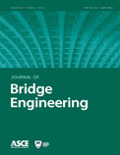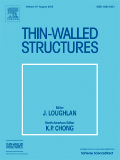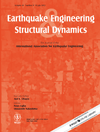
Bridge Structures
Scope & Guideline
Building Knowledge Bridges in Structural Engineering
Introduction
Aims and Scopes
- Structural Analysis and Design:
Research in this area includes analytical and numerical modeling techniques for predicting the behavior of bridge components under various loading conditions, including seismic, wind, and traffic loads. - Material Performance and Rehabilitation Techniques:
The journal publishes studies on the effectiveness of different materials and strengthening techniques, including the use of Fiber Reinforced Polymers (FRP) and other composite materials for enhancing the structural capacity of existing bridges. - Innovative Monitoring and Assessment Technologies:
Papers often explore the integration of advanced technologies, such as Structural Health Monitoring (SHM) systems and Non-Destructive Testing (NDT) methods, for evaluating the condition and performance of bridges over time. - Seismic and Dynamic Response Studies:
A significant focus on understanding how bridges respond to dynamic loads, particularly in seismic regions, with an emphasis on retrofitting and design optimization for improved resilience. - Safety and Reliability Analysis:
Research addressing the redundancy and reliability of bridge systems, particularly in scenarios of component failure or extreme loading conditions, ensuring safe operation throughout their service life.
Trending and Emerging
- Advanced Computational Methods:
There is an increasing trend towards utilizing advanced computational techniques, such as deep learning and machine learning, for predictive modeling and structural health monitoring. - Sustainability and Eco-Friendly Materials:
Research focusing on sustainable practices in bridge construction and the use of eco-friendly materials is gaining traction, aligning with global trends towards environmental conservation. - Impact of Climate Change on Bridge Design:
Emerging studies are beginning to address the implications of climate change on the design and maintenance of bridges, emphasizing the need for adaptive strategies in engineering practices. - Smart Infrastructure and IoT Integration:
The integration of Internet of Things (IoT) technologies in bridge monitoring and maintenance is becoming a significant area of interest, highlighting the move towards smart infrastructure solutions. - Performance-Based Design and Assessment:
A shift towards performance-based design methodologies is evident, focusing on optimizing bridge designs to meet specific performance metrics under varied loading conditions.
Declining or Waning
- Traditional Materials and Designs:
There is a noticeable reduction in publications focused on conventional materials and designs, as the field increasingly embraces modern materials and innovative design approaches. - Basic Load Analysis Techniques:
Papers centered around fundamental load analysis methods are becoming less common, as researchers are moving towards more complex and integrated approaches that account for multiple interacting factors. - Historical Bridge Preservation Techniques:
Research on preservation techniques for historical bridges is decreasing, possibly due to a growing focus on modern engineering solutions and structural innovations.
Similar Journals

Structural Monitoring and Maintenance, An International Journal
Connecting research with real-world structural challenges.Structural Monitoring and Maintenance, An International Journal is a prestigious publication dedicated to advancing knowledge in the fields of civil and structural engineering, as well as safety, risk, reliability, and quality assessment. Published by TECHNO-PRESS in South Korea, this journal serves as a vital platform for researchers, professionals, and students interested in the latest methodologies, technologies, and case studies pertaining to structural monitoring, assessment, and maintenance practices. With its current Q3 category ranking in both structural engineering and safety metrics, the journal aims to promote high-quality research that addresses real-world challenges in structural integrity and safety. As the journal converges its scope from 2014 to 2024, it continues to welcome innovative studies that contribute to the development of sustainable and resilient infrastructures worldwide. Despite the absence of an open-access option, the substantial readership is ensured through its indexed positions, currently ranked among the top journals in its field according to Scopus metrics. Engage with groundbreaking research that shapes the future of structural engineering and safety practices by delving into the contributions this journal offers.

ACI STRUCTURAL JOURNAL
Advancing Concrete Innovation for Tomorrow's StructuresThe ACI Structural Journal, published by the American Concrete Institute, serves as a premier platform for scholarly articles and research findings in the fields of building and construction and civil and structural engineering. With a commitment to advancing concrete technology and its applications, this journal has amassed an impressive reputation, holding a Q2 ranking in both Building and Construction and Civil and Structural Engineering categories as of 2023. The journal’s focus on innovative research and practical applications enables professionals, researchers, and students to stay at the forefront of industry developments. Although it does not offer open access, the content bears significant impact, ensuring that readers engage with high-quality research. As the journal converges its years of publication from 1987 to 2024, it continues to enrich the academic and professional discussions surrounding structural engineering and concrete science.

International Journal of Protective Structures
Fostering innovation in protective structure methodologies.International Journal of Protective Structures is a leading peer-reviewed publication dedicated to advancing the field of protective structures, focusing on innovative designs and methodologies relevant to future applications in safety, risk management, and materials engineering. Published by SAGE Publications Ltd in the United Kingdom, this journal has established itself as a vital resource for researchers, professionals, and students alike, notably holding a strong presence in Scopus rankings within its categories—including Q2 in Building and Construction, Mechanics of Materials, and Safety, Risk, Reliability and Quality. The journal aims to disseminate high-quality research from 2010 to 2024, emphasizing both theoretical and practical implications in its scope. By offering crucial insights into protective structural development and resilience against various risks, International Journal of Protective Structures plays an important role in shaping the discourse within its fields. With an ongoing commitment to accessibility and knowledge sharing, this journal is indispensable for those striving to innovate and implement safe structural engineering practices.

Journal of Bridge Engineering
Fostering Knowledge in the Art of Bridge EngineeringThe Journal of Bridge Engineering, published by the ASCE - American Society of Civil Engineers, is a premier academic journal dedicated to the specialized field of bridge engineering and structural design. With a strong commitment to advancing knowledge from 1996 to 2024, this journal is recognized for its excellence, holding a prestigious Q1 ranking in both the Building and Construction and Civil and Structural Engineering categories according to the latest 2023 metrics. The journal's ISSN 1084-0702 and E-ISSN 1943-5592 signify its commitment to scholarly communication in a digital age. While it does not currently follow an open access model, the Journal of Bridge Engineering significantly impacts the engineering community, appealing to researchers, professionals, and students who seek cutting-edge research and innovative practices in bridge engineering. Its current rankings on Scopus place it among the top journals in its field, reinforcing its role as a critical resource for advancing the state of the art in bridge design, maintenance, and sustainability.

THIN-WALLED STRUCTURES
Connecting Theory with Practical Engineering ApplicationsTHIN-WALLED STRUCTURES is a premier international journal published by Elsevier Science Ltd, focusing on the critical areas of Building and Construction, Civil and Structural Engineering, and Mechanical Engineering. With an impressive impact factor and categorization in the Q1 quartile of each respective field, this journal stands at the forefront of engineering research, boasting commendable Scopus rankings—52nd for Mechanical Engineering, 18th for Building and Construction, and 32nd for Civil and Structural Engineering. Since its inception in 1983, THIN-WALLED STRUCTURES has provided a vital platform for disseminating innovative research, practical applications, and theoretical advancements in thin-walled structures, encouraging the development of safer and more efficient design methodologies. Although it operates on a traditional access model, the journal is committed to maintaining high-quality peer review and publishing, making it an essential resource for researchers, professionals, and students aiming to contribute to and benefit from the latest advancements in this dynamic field.

International Journal of Steel Structures
Bridging Theory and Practice in Steel EngineeringWelcome to the International Journal of Steel Structures, a distinguished publication dedicated to advancing the field of civil and structural engineering since its inception in 2010. Published by the Korean Society of Steel Construction (KSSC), this journal aims to provide a platform for researchers and professionals to share innovative findings and essential insights related to steel structures, emphasizing both theoretical and applied research. With an impact factor that reflects its growing recognition—ranking in Q3 within the civil and structural engineering category—the journal has positioned itself as a significant contributor to the body of knowledge in this vital field. Although currently not an open-access publication, it remains an invaluable resource for students and scholars keen on exploring contemporary challenges and advancements in steel construction. Located in Seoul, South Korea, the journal continues to evolve, converging its presence into the future, with publication efforts spanning through to 2024. Engage with us as we explore the innovative applications and developments in the realm of steel structures.

STRUCTURAL SAFETY
Elevating standards in safety and risk management.STRUCTURAL SAFETY is a premier journal dedicated to advancing the field of engineering with a focus on safety, risk, reliability, and quality in structural analysis and design. Published by Elsevier, this esteemed journal boasts an impressive Impact Factor and ranks in the top quartiles (Q1) of key categories including Building and Construction, Civil and Structural Engineering, and Safety, Risk, Reliability, and Quality. With a significant history spanning from 1982 to 2024, STRUCTURAL SAFETY fosters scholarly exchange among researchers, professionals, and students by publishing innovative and high-quality research articles that contribute to the safety and resilience of engineered structures. The journal operates without open access barriers, ensuring a broad audience can access invaluable insights in the engineering realm. Its distinguished Scopus rankings further underscore its impactful role within the academic community, making it an essential resource for anyone invested in the discipline of structural safety.

Structure and Infrastructure Engineering
Driving Safety and Reliability in Engineering DisciplinesStructure and Infrastructure Engineering, published by TAYLOR & FRANCIS LTD, is a premier academic journal that serves as a vital resource in the fields of engineering and construction. Featuring an ISSN of 1573-2479 and an E-ISSN of 1744-8980, this journal has established its reputation as a leader in disseminating high-quality research. Since its inception, it has successfully transitioned through converged years from 2007 to 2024, earning a prestigious position within the Q1 quartile across multiple engineering disciplines, including Building and Construction, Civil and Structural Engineering, and Ocean Engineering, among others. Its impact is underscored by impressive Scopus rankings, particularly its 5th rank in Ocean Engineering within the top 95th percentile. The journal’s commitment to advancing knowledge in safety, risk, reliability, and quality makes it an indispensable platform for researchers, professionals, and students aiming to stay at the forefront of engineering innovations. Access to its comprehensive articles allows for a deeper understanding of contemporary challenges and solutions in infrastructure development.

Hormigon y Acero
Fostering Collaboration in Structural InnovationHormigon y Acero, an esteemed journal published by the ASOC ESPANOLA INGENIERIA ESTRUCTURAL-ACHE, serves as a vital resource in the fields of structural engineering and construction. With an ISSN of 0439-5689 and an E-ISSN of 2605-1729, this journal plays a critical role in disseminating innovative research and advancements from 2019 to 2024, particularly focusing on concrete and steel applications. Although it does not currently offer open access, its contributions remain invaluable to professionals and academics seeking to enhance their understanding and practices in engineering disciplines. Ranked within the 13th percentile in Building and Construction and the 9th percentile in Civil and Structural Engineering according to Scopus, Hormigon y Acero is recognized for its rigorous peer-reviewed content that addresses contemporary challenges and innovations within the industry. The journal is positioned in Madrid, Spain, and aims to foster collaboration and knowledge exchange among researchers, practitioners, and students dedicated to the advancement of structural engineering.

EARTHQUAKE ENGINEERING & STRUCTURAL DYNAMICS
Driving excellence in earthquake engineering and dynamics.EARTHQUAKE ENGINEERING & STRUCTURAL DYNAMICS, published by Wiley, is a leading journal recognized for its significant contributions to the domains of civil and structural engineering, as well as geotechnical engineering and engineering geology. With an impressive Q1 ranking in multiple categories, including Civil and Structural Engineering, and an esteemed Scopus ranking placing it in the 82nd percentile, the journal serves as a premier platform for disseminating pioneering research and innovative methodologies related to earthquake engineering and dynamic structural analysis. Established in 1972, this journal boasts a comprehensive coverage of topics from theoretical developments to practical applications, making it an essential resource for researchers, industry professionals, and students eager to expand their understanding of seismic safety and structural resilience. Though it does not offer open access, the journal continues to be a cornerstone for scholarly communication within the earthquake engineering community, advancing knowledge that shapes better engineering practices worldwide.